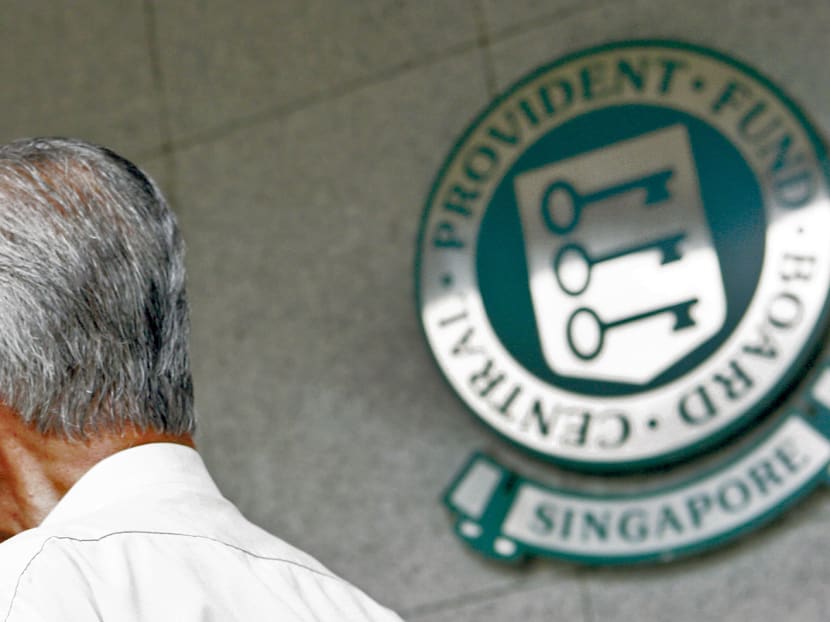CPF — leave your money in or take it out?
It can be tempting to start taking money out of your CPF account as soon as you turn 55. Indeed, anyone who turns 55 can immediately take money out of CPF as long as they meet minimum sum requirements. Some may use it for anything from daily expenses or renovating their flat to vacations or fancy meals. Others, confident investors who believe they can grow their savings faster themselves, may invest it.

A member of the public walks past the CPF building. File photo
It can be tempting to start taking money out of your CPF account as soon as you turn 55. Indeed, anyone who turns 55 can immediately take money out of CPF as long as they meet minimum sum requirements. Some may use it for anything from daily expenses or renovating their flat to vacations or fancy meals. Others, confident investors who believe they can grow their savings faster themselves, may invest it.
SPENDING THE MONEY
While data on how many people take out funds from CPF and what they do with it is limited, many people do take out at least part of their money and spend at least part of it.
NUS Professor Sumit Agarwal and his colleagues found in their research last year that there is a large increase in bank account balances when individuals here turn 55, suggesting that consumers withdraw a large portion of their eligible retirement savings.
These people, especially “low-liquidity” consumers, also increased their cumulative spending by about 9 per cent. They also left a “sizeable portion” of their withdrawn savings in low-interest bank accounts for at least a year, too, rather than investing it more productively.
Consumers abroad seem to follow a similar path. The most recent study of superannuation in Australia, which is similar to CPF, showed that 54 per cent of retirees took out all or part of their funds as a lump sum payment. About one-third used it to pay off or improve or purchase a home, while about 15 per cent used it to buy or pay off a motor vehicle. Only about 36 per cent reinvested it
While spending a little can be pleasant, it also reduces the amount available for a comfortable retirement, a key purpose of CPF savings.
TAKING OUT THE MONEY
Another part of the reason people here take money out of CPF may be that they are increasingly optimistic about their investing capabilities.
The 2016 Blackrock Investor Pulse Survey found that Singaporeans expect a return of 8.4 per cent on all the investments they manage on their own, for instance, and more than half of Singaporeans are confident that they are making the right savings and investment decisions.
Some investors may indeed make more by investing than what they would earn with CPF. Despite that confidence in high returns, however, actual results in recent years for most people have not been nearly as good as they expect.
While investing in shares had been a good option, the Straits Times Index dropped more than 10 per cent in 2015 and was down nearly another 2 per cent by early August.
More conservative investors who turned to REITS would have had a negative return of about 2 per cent last year and a three-year return averaging just 2.3 per cent.
Bonds are hardly doing any better, as the three-year return for the ABF Singapore Bond Index Fund averaged just 3 per cent, despite a stellar 6.35 per cent rise this year. Inflation-protected Singapore Savings Bonds recently paid 2.03 per cent. And pity the poor consumers who invested in previously-well-regarded bonds of companies such as Swiber.
While direct property investments have also been popular, residential property investment site Global Property Guide opined that “gross rental yields in Singapore remain poor, at around 2.5 per cent,” and “prices have been falling gently over the past 2 years.”
Even investors who kept their money in CPF and invested through the CPF Investment Scheme (CPFIS) didn’t fare well. Data from CPF showed that 84 per cent of CPFIS investors did not make enough to match the default 2.5 per cent interest rate or lost money last year.
LEAVING THE MONEY IN
While there is no shortage of complaints about CPF interest rates, leaving money in your account actually pays a decent return. CPF members currently earn interest rates of up to 3.5 per cent on their Ordinary Account and up to 5 per cent on their Special and Medisave accounts.
Retirement accounts do even better, earning up to 6 per cent on the first S$30,000 and up to 5 per cent on the rest. While share or bond markets could improve in the future, those CPF interest rates beat the other options handily in recent years.
High volatility and low interest rates could make it challenging for investors to exceed those CPF returns for some time to come.
The variety of retirement schemes that have come out recently give more options as well.
Someone who has enough to put the minimum sum of S$80,500 in their CPF Life account is assured of receiving about S$660 or more per month for life, while people who have more and put it into CPF Life would have even higher monthly pay-outs.
The new escalating payouts and Lifetime Retirement Investment Scheme add even more options.
WHAT TO DO
While it can be quite tempting to take CPF money out, returns on money invested outside CPF may not yield as much as CPF itself, and research shows that part of the money will likely be spent.
For consumers who want to ensure a comfortable retirement, leaving money in CPF may be a better option.





